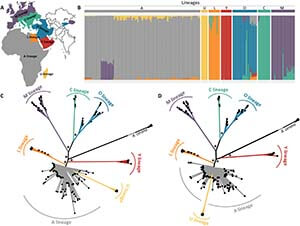
As I sit down to write the fiftieth Notes from the Lab, I find myself thinking about how this column got started.
Notes from the Lab was inspired by Roger Morse, the famed former professor of apiculture at Cornell, who penned a monthly column called “Research Review” for over forty years. When I started at Cornell, it seemed appropriate to revive a column with a similar goal: highlighting the latest cool bee research. I’ve been writing this column for four years now, so I guess I have thirty-six to go until I catch up to Morse. It’s been a lot of fun so far!
With this origin story in mind, perhaps it’s appropriate that the topic for this month’s Notes from the Lab is the origin of our Western honey bee, Apis mellifera. Have you ever looked at your bees and wondered where they originally came from? What about all those A. mellifera subspecies and lineages; where and when did they evolve, how are they related to each other, and what parts of their genetic code do they share? These are the topics for our fiftieth Notes from the Lab, where we summarize “Thrice out of Asia and the adaptive radiation of the western honey bee,” written by Kathleen Dogantzis and colleagues and published in Science Advances [2021].
For their study, Dogantzis and colleagues analyzed the genomes of 251 individual A. mellifera samples representing 14 subspecies. The authors added to an existing A. mellifera database by collecting 160 new bee samples from throughout Europe, Africa, and Asia. In other words, they collected lots of A. mellifera from its entire natural range with the goal of revealing and comparing as much of its genetic variation as possible.
All samples were sequenced and aligned, and single-nucleotide polymorphisms (SNPs, pronounced “snips”) were identified. If you’ve never heard of a SNP, its name describes it fairly well: a place in the genome where a single nucleotide (i.e., an A, T, C, or G) is different for some individuals compared to others. For example, your honey bees might have an A at a particular position, while my bees might have a G at that same position. That’s a SNP.
Looking in detail at all of the SNPs allowed the authors to determine genetic variation among all 251 bee samples, how they were related, and with a couple of assumptions, when particular lineages diversified. In total, Dogantzis and colleagues analyzed 11.8 million SNPs – a very impressive dataset!
So, what did they find? Is there clear separation between the current A. mellifera lineages? Yes. As seen in Figure 1, the data reveal there are seven distinct lineages of Western honey bees. Lineage A (gray in Figure 1) is present across most of Africa, lineage L (orange) is present in Egypt, lineage U (yellow) is present in Madagascar, lineages Y and O (red and blue) are present in Asia, lineage C (turquoise) is present in Europe, and lineage M (purple) is present in Eurasia.
But look closely at panel B of Figure 1. Each narrow vertical column represents one of the 251 individual A. mellifera samples. As you can see, the colors for each lineage aren’t completely solid. This means some of the bees from a particular lineage share genes with another lineage. In other words, clearly there’s some recent mating that’s occurred between those particular lineages. This is especially clear for the O lineage (blue), which includes the subspecies A.m. syriaca. This subspecies shares 76.8% of its genome with lineage O, but it also shares 12.6% of its genome with lineage A, 4.4% with Y, and 4.4% with L. Given its geographic position between Africa and Asia, perhaps this evidence of recent cross-lineage mating should not be surprising.
How are the A. mellifera lineages related to each other? As seen in Figure 1C-D, the seven lineages are related to each other very similarly no matter how the data are analyzed (i.e., using SNPs in the whole genome, as shown in panel A, or only protein-coding SNPs, as shown in panel B). This means we’re very confident in the overall pattern of relatedness among lineages, which allows the authors to ask more sophisticated questions about relatedness and evolution.
OK, let’s get to it. When and where did A. mellifera originate and evolve? About six million years ago in Asia, with at least three expansions into Europe/Africa since. As seen in Figure 2, the authors assigned dates to the origin of each subspecies and traced those origins through time, again using the two methods of ….


